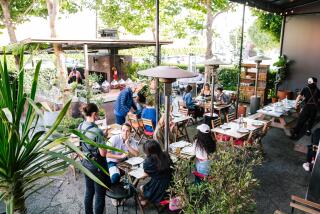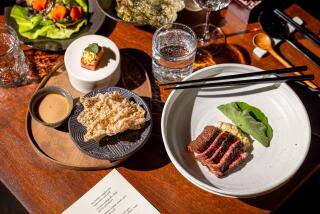Glories of the Past and Present Attract Visitors
- Share via
HERAKLION, Greece — While the Western World is forever indebted to the full flowering of Greek philosophy and culture beginning about 500 BC, another highly developed civilization had already flourished 1,500 years earlier on Crete, the largest island of the Eastern Mediterranean.
The refinements and artistic achievements of the Minoan culture, best exemplified by the exquisite Palace of Minos at nearby Knossos, probably began as early as 6000 BC. They were rebuilt from a number of catastrophic earthquakes and finally reduced to rubble by the volcanic explosion and tidal waves from a gigantic eruption on the island of Santorini to the north around 1450 BC.
At the turn of this century the Englishman Sir Arthur Evans discovered the Palace of Minos site and began its restoration. It, and the priceless artifacts and frescoes in Heraklion’s Archeological Museum, tell a colorful story of those ancient people.
Yet Crete, like most of Greece and its islands, offers us more than just a fascinating look at the past. You’ll find broad, sunny beaches, soul-satisfying food and wine in modest tavernas, noble yet warm and fun-loving people.
Is it any wonder that Crete gave us both El Greco and bullfighting, each making the way eventually to Spain, or that rustic but lovable rogue Zorba?
Here to there: Fly Pan Am to Athens with a stop in Frankfurt, TWA with a change in New York. Several domestic lines will get you to JFK for a change to Olympic Airways for Athens nonstop, foreign carriers with a stop in their home countries. Take Olympic for the 50-minute flight on to Heraklion.
How long/how much? We’d give it two days for the town and palace at Knossos a few miles south, one or two more for other nearby Minoan sites, Byzantine churches and monasteries, marvelous beaches on both shores of this 160x36-mile island. Costs for lodging and food throughout Greece are ludicrously low.
A few fast facts: The Greek drachma was recently worth .0073, 138 to the dollar. Crete is only 200 miles from the African coast, so weather is superb most of the year, sea breezes helping with midsummer heat. Get about the island on a good bus system, or rent a small car for about $29 daily, a motor scooter for two for around $10.
Getting settled in: We’ve watched Hotel Xenia ($30 B&B; double from mid-March through October, $25 off-season) grow through the years into a large and ultramodern place right on the water, huge pool and dining room, bar, excellent rooms and baths. Most bedrooms have balconies overlooking the sea, short walk to center of town.
Astoria Capsis ($45 B&B; double high-season, $35 low) is right at the center of things on Museum Square. It’s another modern one with rooftop pool, second-floor dining room overlooking the square, bright and comfortable rooms with balconies, a pub and disco for night owls.
Atlantis ($37 B&B; summers, $33 off-season) is cut from the same bolt as those above and, like the Astoria, charges about $3 more for an air-conditioned room. This is another large one near museum, rooftop pool with light dining, most room balconies have view of harbor, lots of games and et cetera to keep kids happy, lunch or dinner $7, even less if you take half or full pension.
Regional food and drink: Seafood and more seafood, almost all of it fresh and still flipping from the Mediterranean, plus solid Greek standbys such as souvlakia of meat or seafood grilled on skewers, moussaka and pastitsio casseroles, avgolemono soup. We developed a close friendship this trip with fangri, a fish found only in the Eastern Mediterranean that is almost too delicious to describe. And we find it hard to get through a meal here without squid or octopus, grilled or marinated as a meze (hors d’oeuvre).
Greek fruit, particularly the figs and melons, is among the world’s best. And the country’s vegetables rise to lofty heights in the simple Greek salad of tomatoes, cucumbers, feta cheese, olives and onions, all cut into chunks, doused with olive oil and lemon juice, then sprinkled with fresh oregano.
Any visitor should at least try the white retsina wine, named for the resin flavor once given this liquid sunshine by the rosin-caulked barrels used for shipping. You may go back to the straight stuff, but retsina is the perfect mate for hearty Greek food.
Moderate-cost dining: If we had to choose the town’s most typical taverna it would have to be To Sokaki (25 Merabelou St. near museum). Two blinding white patios, one reed covered, the other with a small, flower-decked well, Greek-blue shutters and place mats, fresh carnations on the tables.
We loaded our table with the likes of fangri, grilled octopus, squid, sea bream and red mullet, preceded by a host of marvelous mezes and washed down with Latodiana white Cretan wine. Everything comes from the kitchen across the tiny street, and you’ll leave full and happy for about $4 each, including wine and a pre-prandial ouzo to sharpen taste buds.
Kyriakos (Dimocratias Avenue on street leading to Knossos) will dish up more of the same, Kalathakis (by Palace of Minos) still more along with bouzouki music to liven your meal. A clutch of cafes and tavernas ring Lion Square, still more line Dedalou Street leading from there up to Museum Square. Good shopping along Dedalou as well.
On your own: Lead off with a visit to Knossos, allowing yourself at least a couple of hours to soak up this crown jewel of Minoan civilization. Then set aside equal time for the Archeological Museum with its magnificent collection of artifacts and frescoes from the palace site.
The half-man, half-bull Minotaur legend is strongly associated with Knossos, topless maidens vaulting over bulls’ horns in museum frescoes probably the genesis of latter-day bullfighting.
Apart from being sprinkled liberally with monuments and remains of the Minoan, Byzantine, Venetian and Saracen eras, Crete’s sunny shores are a necklace of picturesque bays and fishing villages. Lovely Agios Nikolaos, snug on Mirambelou Bay just 40 miles east, is probably the island’s most popular resort. Limenas Hersonissou, about half that distance, is another one where you’ll find more hotels and tavernas than the capital offers.
For more information: Call the Greek National Tourist Organization at (213) 626-6696, or write (611 W. 6th St., Los Angeles 90017) for a colorful 16-page booklet on Crete with history, sights, map of the island and list of hotels in 60 towns and villages. Ask for the Crete package.
More to Read
Sign up for The Wild
We’ll help you find the best places to hike, bike and run, as well as the perfect silent spots for meditation and yoga.
You may occasionally receive promotional content from the Los Angeles Times.






